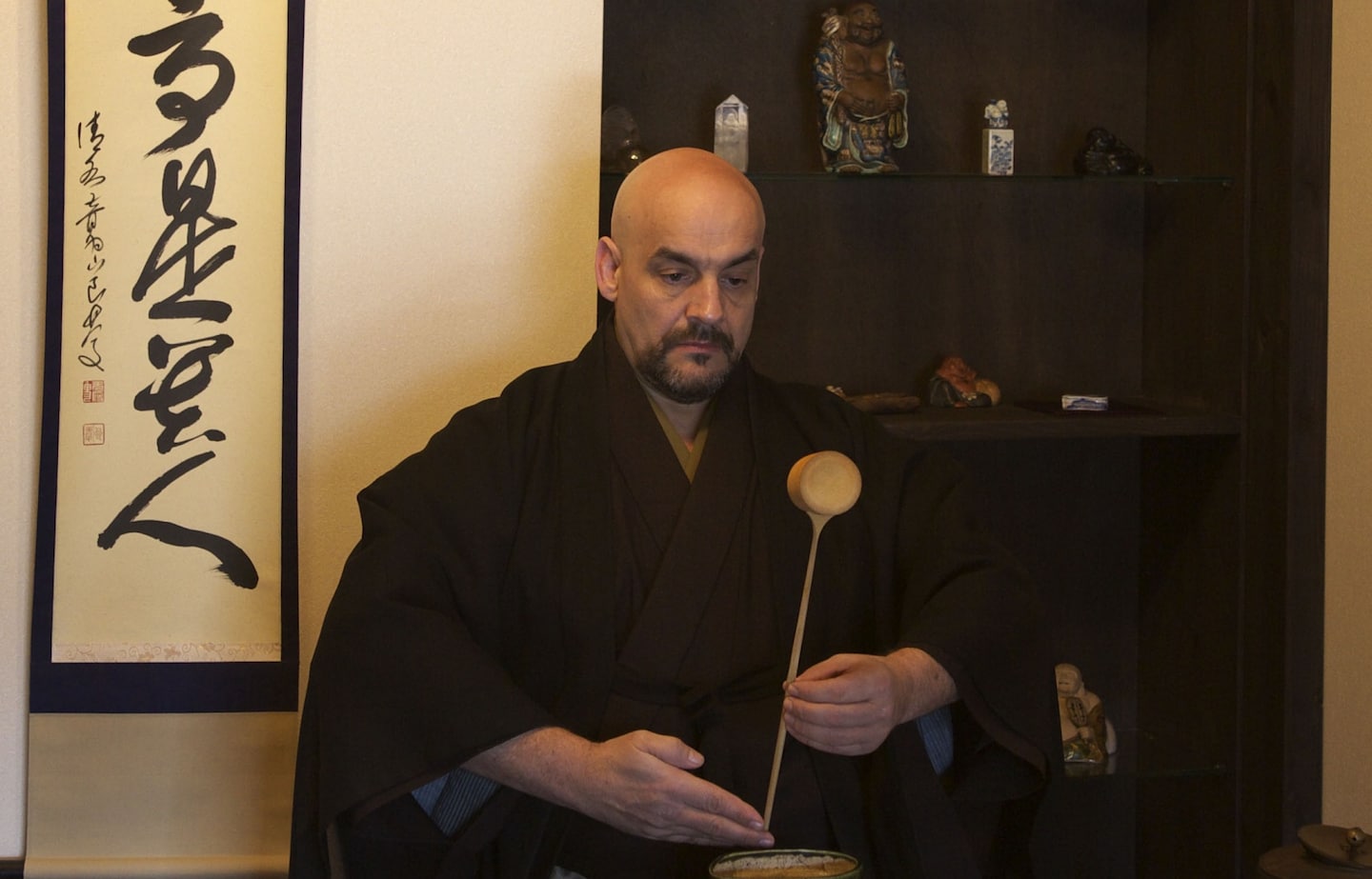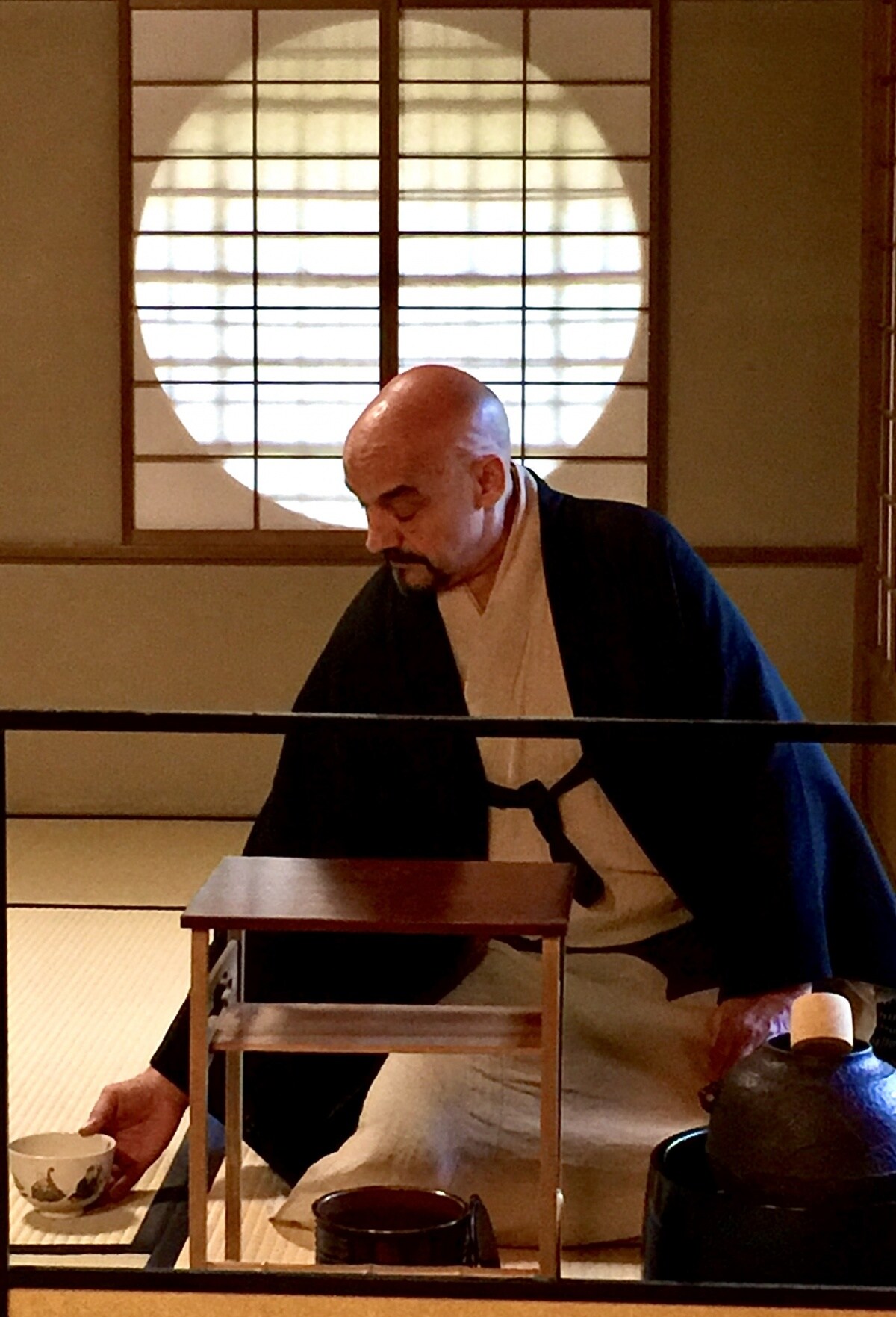From the Way of the Warrior to the Way of Tea

Canadian Randy Channell Soei came to Japan to pursue the martial arts. Now he teaches Chado, the Way of Tea, more commonly referred to as the tea ceremony. He is a professor at Doshisha University and the author of The Book of Chanoyu: Tea the Master Key to Japanese Culture. He owns ran Hotei, a small Japanese café /gallery in Kyoto.
By Tim Hornyak"Tea and budo share many connections, philosophical, spiritual, and even with Zen. But what I noticed immediately were the many similarities in movement."
What led you to travel to Asia?
Bruce Lee! I spent several years studying kung-fu in Hong Kong but decided to move to Japan to begin studying budo. I had learned a term that became my guiding philosophy: bunburyodo, or “the way of the cultural and martial arts.” It was this blend of the cultural and martial that I was looking for. I’ve been living here in Japan a long time now, over 35 years.
As a martial arts practitioner, what drew you to chanoyu, the Way of Tea?
Tea and budo share many connections, philosophical, spiritual, and even with Zen. But what I noticed immediately were the many similarities in movement. Our posture when we sit, the way we stand, bow, move and even hold things. My first tea experience was very profound. I remember it to this day as if it were yesterday even though it’s over 35 years ago! My neighbor was a sensei of chanoyu and she was gracious enough to give me a demonstration. She had never done anything related to the martial arts but for me it was easy to see the connections as she went through her procedure.
What school are you affiliated with?
I belong to the Urasenke tradition of tea. It is one of three traditions that have a direct blood lineage to [tea ceremony pioneer] Sen no Rikyu. It is the largest school of tea and has a wide representation of branches and clubs overseas. This is thanks to the previous Grandmaster Sen Genshitsu devoting over 60 years of his life spreading his maxim of “Peacefulness through a bowl of tea.” I was lucky enough to attend the Urasenke college. After three years, I graduated and started teaching tea. This year marks my 25th year of teaching chanoyu.
What’s your approach to teaching?
Because of my martial arts background, I concentrate more on the actual procedures as opposed to what I call the “academic” side of tea. I want my students to have a flow, not one that is forced or conscious, but one that moves without thought. I often speak of the importance of breathing. I do have the reputation of being somewhat strict and I can be a little bit terse sometimes. But I’m not being mean, it’s ai no muchi, love’s whip, as we say in Japanese.
What kind of people study tea, and what do they get out of it?
All kinds of people! I guess to get a true answer to the second part you’d have to ask individual students. Depending on their background, age, sex and knowledge of tea, they will all get something different. Regardless of who studies, it has been my experience that at some point all will enjoy the quiet solitude offered in the tearoom.
"I’m at the proverbial tip of the iceberg. Tea is an all-encompassing art form, and each facet of the Way of Tea is, like tea, a lifelong study. "

How long does it take to have basic proficiency in tea ceremony?
Like everything, it varies. It also depends on how often you study. If you attend a lesson once a week and you’re focused, within a year you should be able to make tea for your friends at least. I teach a 15-lesson course at Doshisha University and at the end of it many of the students can perform a very basic tray procedure.
Most tea masters don’t have cafés, I would imagine.
Most tea masters are much smarter than I am! I opened my shop ran Hotei, rather foolishly, in 2007. Having my own place gives me the ability to host events any time I want to give people a place where they can experience the tea ceremony in a relaxed atmosphere without having to know all the proper etiquette. Many people are intimidated because they don’t know what to do. I also created my own line of matcha. My teas have been very well received and I am always happy to hear from people who have tried them.
What about the fact that you’re not from Japan?
I think the uniqueness gives me a bit of prominence as well as a bit of pressure! I do get a fair bit of media exposure so I have to be extra careful not make mistakes and that hopefully my Japanese isn’t so bad as to offend. My goal is to at least plant seeds of interest in the way of tea so hopefully some will begin to study.
Is chanoyu popular these days?
As the Way of Tea is one of sharing, the pandemic has had a very deep impact. To adhere to the “rules” regarding social interaction many of the protocols of tea had to be adapted. So in the past two years I’d say there has been a decline in the population of people doing tea, but the desire of people to spend real time together is strong so the interest in tea is there.
What do you think the future holds for the tea ceremony?
Once we achieve a “new normal” I’m hopeful things will change for the better. What I hope is that the Four Principles of Tea will bring people back together and open up new and meaningful relations. Though written around 500 years ago, they are as valid today as they were in the past and will be in the future: Harmony, Respect, Purity and Tranquility still resonate deeply in the human psyche, perhaps more now than before. They are timeless.
After studying the Way of Tea for so long, is there anything left to learn?
Yes! I feel I’m still learning—not even close to knowing what I should! I’m at the proverbial tip of the iceberg. Tea is an all-encompassing art form, and each facet of the Way of Tea is, like tea, a lifelong study. In fact, the more I know, the more I realize the less I know. Let’s call it a Zen thing!



